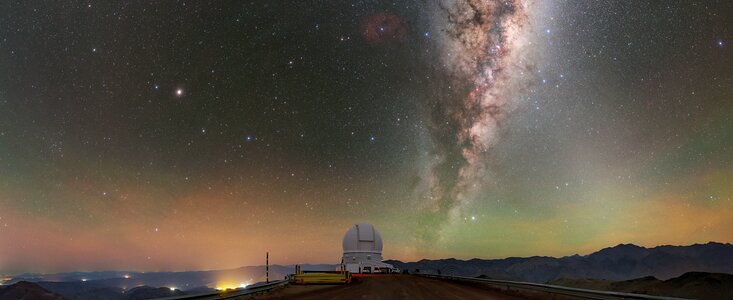New Lighting Standard in Chile Will Preserve the Night Skies Across the Entire Country
A new Norma Luminica has been issued in Chile that will reduce light pollution by placing stricter regulations on light-emitting sources
30 October 2023
On 18 October 2023 Chile issued a new lighting standard to protect the country’s clear, dark skies, which are valued by a large selection of the world’s astronomical infrastructure, including NSF's NOIRLab. Established by the Chilean Ministry of the Environment, this new standard expands on the existing decree that was established in 2012 with the objective of preserving the astronomical quality of the night skies in the Regions of Antofagasta, Atacama, and Coquimbo.
The new Norma Luminica, formally titled Supreme Decree No. 1 of 2022, is a revision of Supreme Decree No. 43 of 2012 that expands the scope of regulations on light-emitting sources to the entire country of Chile. And not only does it protect the night skies for astronomical observations, but it also incorporates the protection of biodiversity and human health as environmental objectives.
The new Norma Luminica includes regulations on the brightness of industrial lighting, placing limits on the average light levels (luminance or illuminance) that emitting sources can produce. Similar limits are imposed on vehicular, pedestrian, and sports lighting. The new standard also promotes the transition towards the use of warm light by imposing stricter restrictions on the emission of blue light such as that emitted by LEDs (Light Emitting Diodes). These restrictions will be implemented across the entirety of Chile with stricter regulations in Special Protected Areas, which include Astronomical and Biodiversity Areas. This requirement applies to vehicular, pedestrian, and industrial lighting, and it pertains to both new and existing light fixtures within Protected Areas, which encompasses all the communes in the surroundings of NOIRLab’s Chile observatories such as Vera C. Rubin Observatory.
“The new regulation is a tremendous triumph and the result of the joint effort of dozens of people who knew how to work collectively,” said Alejandra Voigt, Vice President and Head of Mission for AURA Observatory in Chile. “This includes the two previous AURA Heads of Mission, the OPCC, the heroic professionals at the Ministry of the Environment, various authorities from the Ministry of Foreign Affairs, astronomers from NOIRLab and La Serena University working in light pollution, the communities that depend on the night sky of the Elqui Valley, and the unwavering support of all Chilean Ministers of Science.”
Light pollution is a real and pressing problem for astronomy. An analysis of data from NOIRLab’s citizen-science program Globe at Night showed that the night sky in developing countries has increased in brightness at a rate of 9.6% per year over the past decade. This increase in light pollution not only poses a threat to human health, but there is convincing evidence that it also negatively affects various ecological and biological systems.
The creation of these new standards benefitted from the collaboration of NOIRLab and other professional observatories installed in Chile, through the Office for the Protection of the Sky Quality in Northern Chile, as well as the advice of the Cielos de Chile Foundation.
“The update of the light standard, added to the recent decree that creates areas with scientific and research value for astronomical observation, demonstrates Chile's commitment to create an institutional framework that supports science-based development,” said Daniela González, Director of the Fundación Cielos de Chile.
This Norma Luminica is the second update to the original lighting standard, Supreme Decree No. 686 of 1998, which was aimed at protecting the future of astronomy in northern Chile. Malcolm Smith, astronomer and director of Cerro Tololo Inter-American Observatory in Chile from 1993 to 2003 and an advocate for the protection of the night sky, was instrumental in the passing of the first Norma Luminica and is pleased to see the protections now extended to all of Chile.
"The effort of all of us has been combined successfully to produce an excellent result,” he said. "Everyone gains."
More information
NSF’s NOIRLab (National Optical-Infrared Astronomy Research Laboratory), the US center for ground-based optical-infrared astronomy, operates the International Gemini Observatory (a facility of NSF, NRC–Canada, ANID–Chile, MCTIC–Brazil, MINCyT–Argentina, and KASI–Republic of Korea), Kitt Peak National Observatory (KPNO), Cerro Tololo Inter-American Observatory (CTIO), the Community Science and Data Center (CSDC), and Vera C. Rubin Observatory (operated in cooperation with the Department of Energy’s SLAC National Accelerator Laboratory). It is managed by the Association of Universities for Research in Astronomy (AURA) under a cooperative agreement with NSF and is headquartered in Tucson, Arizona. The astronomical community is honored to have the opportunity to conduct astronomical research on Iolkam Du’ag (Kitt Peak) in Arizona, on Maunakea in Hawai‘i, and on Cerro Tololo and Cerro Pachón in Chile. We recognize and acknowledge the very significant cultural role and reverence that these sites have to the Tohono O’odham Nation, to the Native Hawaiian community, and to the local communities in Chile, respectively.
Links
- Office for the Protection of the Sky Quality in Northern Chile (OPCC)
- Cielos de Chile Foundation
- Read about NOIRLab’s work protecting our astronomical sites
Contacts
Javier Sayago
Oficina de Protección de la Calidad del Cielo del Norte de Chile
Email: javier.sayago@noirlab.edu
Daniela González
Fundación Cielos de Chile
Email: dgonzalez@cieloschile.cl
Connie Walker
NSF’s NOIRLab
Office of Observatory Site Protection
Email: connie.walker@noirlab.edu
Josie Fenske
NSF’s NOIRLab Communications
Email: josie.fenske@noirlab.edu




